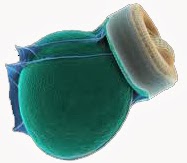 Dinoflagellates are unicellular protists which
exhibit a great diversity of form. The largest, Noctiluca, may be as large as 2 mm in diameter! Though not large
by human standards, these creatures often have a big impact on the environment
around them. Many are photosynthetic, manufacturing their own food using the
energy from sunlight, and providing a food source for other organisms. Some
species are capable of producing their own light through bioluminescence,
which also makes fireflies glow. There are some dinoflagellates which are parasites
on fish or on other protists.
Dinoflagellates are unicellular protists which
exhibit a great diversity of form. The largest, Noctiluca, may be as large as 2 mm in diameter! Though not large
by human standards, these creatures often have a big impact on the environment
around them. Many are photosynthetic, manufacturing their own food using the
energy from sunlight, and providing a food source for other organisms. Some
species are capable of producing their own light through bioluminescence,
which also makes fireflies glow. There are some dinoflagellates which are parasites
on fish or on other protists. Dinoflagellates possess a unique nuclear structure at some stage of their life cycle - a dinokaryotic nucleus (as opposed to eukaryotic or prokaryotic), in which the chromosomes are perminently condensed. The cell wall of many dinoflagellates is divided into plates of cellulose ("armor") within amphiesmal vesicles, known as a theca. These plates form a distinctive geometry/topology known as tabulation, which is the main means for classification.
The most dramatic effect of dinoflagellates on life around them comes from the coastal marine species which "bloom" during the warm months of summer. These species reproduce in such great numbers that the water may appear golden or red, producing a "red tide". When this happens many kinds of marine life suffer, for the dinoflagellates produce a neurotoxin which affects muscle function in susceptible organisms. Humans may also be affected by eating fish or shellfish containing the toxins. The resulting diseases include ciguatera (from eating affected fish) and paralytic shellfish poisoning, or PSP (from eating affected shellfish, such as clams, mussels, and oysters); they can be serious but are not usually fatal.
 Both heterotrophic (eat other organisms) and autotrophic (photosynthetic)
dinoflagellates are known. Some are both. They form a significant part of
primary planktonic production in both oceans and lakes. Most dinoflagellates go
through moderately complex life cycles involving several steps, both sexual and
asexual, motile and non-motile. Some species form cysts composed of
sporopollenin (an organic polymer), and preserve as fossils. Often the
tabulation of the cell wall is somehow expressed in the shape and/or
ornamentation of the cyst.
Both heterotrophic (eat other organisms) and autotrophic (photosynthetic)
dinoflagellates are known. Some are both. They form a significant part of
primary planktonic production in both oceans and lakes. Most dinoflagellates go
through moderately complex life cycles involving several steps, both sexual and
asexual, motile and non-motile. Some species form cysts composed of
sporopollenin (an organic polymer), and preserve as fossils. Often the
tabulation of the cell wall is somehow expressed in the shape and/or
ornamentation of the cyst.Most zooxanthellae are dinoflagellates. The association between dinoflagellates and reef-building corals is widely known, but dinoflagellate endosymbionts inhabit a great number of other invertebrates and protists, for example many sea anemones, jellyfish, nudibranchs, the giant clam Tridacna, as well as several species of radiolarians and foraminiferans. Many extant dinoflagellates are parasites (here defined as organisms that eat their prey from the inside, i.e. endoparasites, or that remain attached to their prey for longer periods of time, i.e. ectoparasites). They can parasitize animal or protist hosts. Protoodinium, Crepidoodinium, Piscinoodinium and Blastodinium retain their plastids while feeding on their zooplanktonic or fish hosts. In most parasitic dinoflagellates the infective stage resembles a typical motile dinoflagellate cell.
Dinoflagellates are protists which
have been classified using both the International
Code of Botanical Nomenclature (ICBN) and the International Code of
Zoological Nomenclature (ICZN). Approximately half of living dinoflagellate
species are autotrophs possessing chloroplasts and half are non-photosynthesising
heterotrophs. It is now widely accepted that the ICBN should be used for
their classification.



